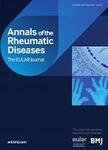版权所有:内蒙古大学图书馆 技术提供:维普资讯• 智图
内蒙古自治区呼和浩特市赛罕区大学西街235号 邮编: 010021

作者机构:W Glasgow Hosp Univ NHS Trust Gartnavel Gen Hosp Dept Rheumatol Glasgow G12 0YN Lanark Scotland
出 版 物:《ANNALS OF THE RHEUMATIC DISEASES》 (风湿病纪事)
年 卷 期:1999年第58卷第8期
页 面:510-513页
核心收录:
学科分类:1002[医学-临床医学] 100201[医学-内科学(含:心血管病、血液病、呼吸系病、消化系病、内分泌与代谢病、肾病、风湿病、传染病)] 10[医学]
主 题:抗风湿药/投药和剂量 抗风湿药/治疗应用 关节炎 类风湿/诊断 关节炎 类风湿/诊断显像 关节炎 类风湿/药物疗法 用药计划表 专业业务/发展趋势 放射摄影术 转诊和会诊/发展趋势 回顾性研究 苏格兰 时间因素 成年人 老年人 女(雌)性 人类 男(雄)性 中年人
摘 要:Objectives-To study the delay in starting disease modifying anti-rheumatic drugs (DMARDs) in patients with rheumatoid arthritis (RA), and any changes in medical practice between 1980 and 1997. Methods-198 consecutive RA patients attending the rheumatology clinics at a teaching hospital, for routine review, had their case sheet reviewed. The dates of symptom onset, general practitioner (GP) referral, first clinic appointment and first use of DMARD were recorded. Data were collected on the erythrocyte sedimentation rate, C reactive protein, rheumatoid factor, and the presence/absence of erosions at the first clinic assessment. Patients were split into four groups according to the date of their first clinic assessment-before 1986, 1987-9, 1990-3, and 1994-7. Results-There was a sharp drop in the delay between symptom onset and GP referral (before 1986, 21 months;1987-89, 23 months;1990-3, 7 months;1994-7, 4 months, p0.03), and in the delay between first assessment at the rheumatology clinic and the start of DMARD treatment (before 1986, 32 months;1987-89, 21 months;1990-1993, 8 months;1994-7, 1 month, p0.001). The number of patients given DMARD treatment within six months of symptom onset increased from 5% (before 1994) to 44% (1994-7). Seventy three per cent of patients waiting more than a year from symptom onset to first clinic appointment already had erosive change, compared with 34% of patients seen within a year. Conclusions-Patients are being referred earlier in their disease, and DMARDs are prescribed sooner in the disease course. There has been a substantial increase in the proportion of patients treated with a DMARD within six months of symptom onset.